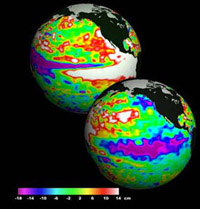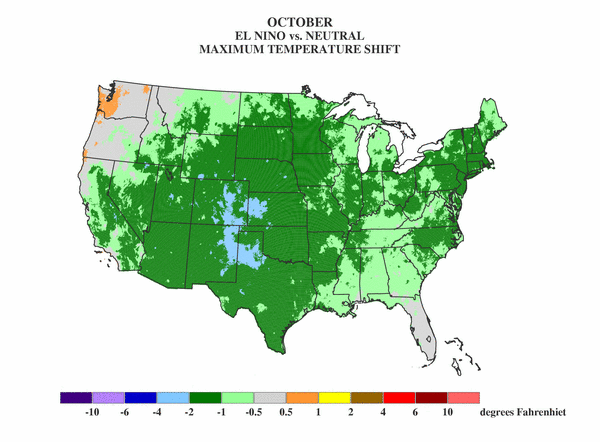- Climate Versus Weather
- What are El Niño and La Niña?
- El Niño Climate Variation Animations
- El Niño/La Niña Impacts Across the Southeast U.S.
Climate Versus Weather
Climate is the long-term (monthly or longer) pattern of weather conditions in a region. Climate is not the same as weather.
Weather deals with the short-term movement and development of individual weather systems (fronts, cyclones, air masses).
The earth's climate is a dynamic system, with regional variations on many different time scales from seasonal, to year-to-year, up to decades and even longer.
What are El Niño and La Niña?
El Niño is a warming of the ocean surface along the equator in the Pacific. During a strong El Niño, surface temperatures can rise as much as 15°F above normal from the coast of Peru across the central Pacific. The heat and humidity from El Niño changes global atmospheric circulation and disrupts weather and climate patterns in many regions around the world.
During a La Niña, the same region of the Pacific Ocean cools. Though the temperature change is usually not as drastic, La Niña occurs just as frequently as the better-known El Niño.

Neutral is the term used when neither El Niño nor La Niña is present in the Pacific. About half of all years are classified as neutral years.
El Niño and La Niña events tend to repeat roughly every four to seven years, although one is not always followed by the other.
This image shows the unusual warming of the tropical Pacific during the 1997 El Niño (top left) and abnormal cooling during the last La Niña (bottom right),courtesy of NASA.
El Niño Climate Variation Animations
A series of animations are available below from AgroClimate , highlighting the impacts of El Niño and La Niña on precipitation and maximum and minimum temperatures across the United States.

Example diagram from the movies detailing differences in temperature associated with an El Niño winter.
El Niño/La Niña Impacts Across the Southeast U.S.
The following table provides a summary of the effects on temperature and precipitation across the Southeast:
| Phase | Region | Oct-Dec | Jan- Mar | Apr-Jun | Jul-Sep |
|---|---|---|---|---|---|
| El Nino | Peninsular Florida | Wet & cool | Very Wet & cool | Slightly dry | Slightly dry to no impact |
| Tri-State Region | Wet | Wet | Slightly wet | No impact | |
| Western Panhandle | No impact | Wet | Slightly Dry | No impact | |
| Central and North Ala. & Ga. | No impact | No impact | No impact | Slightly Dry | |
| La Niña | Peninsular Florida | Dry & slightly warm | Very dry & warm | Slightly wet | Slightly cool |
| Tri-State Region | Slighly dry | Dry | Dry | No impact | |
| Western Panhandle | Slightly dry | Dry | Dry | No impact | |
| Central and North Ala. & Ga. | Dry | Dry in the south, wet in NW Ala. | No impact | Wet in NW Ala. | |
| Neutral | All Regions | No impact | No impact | No impact | No impact |
An important addition not highlighted in the table, however, is the probability of a debilitating freeze across the region during each of these three phases. During a neutral phase, the likelihood of a severe freeze is much greater than during either an El Niño or a La Niña event. Appropriate precautions should be taken to minimize potential losses in the event of a severe freeze during one of these years. For more information on freezes see the AgroClimate Freeze Forecast.

